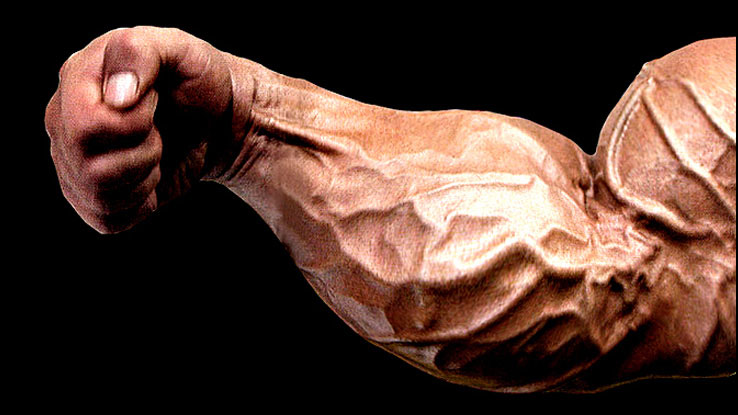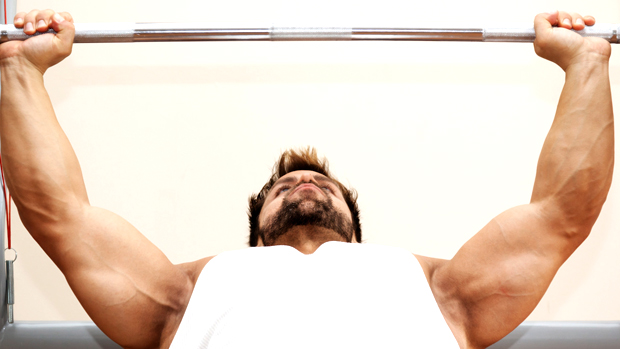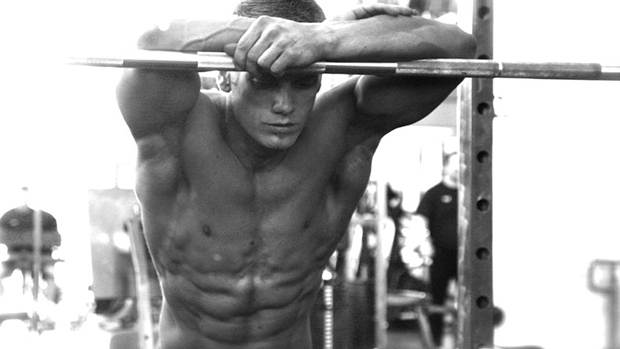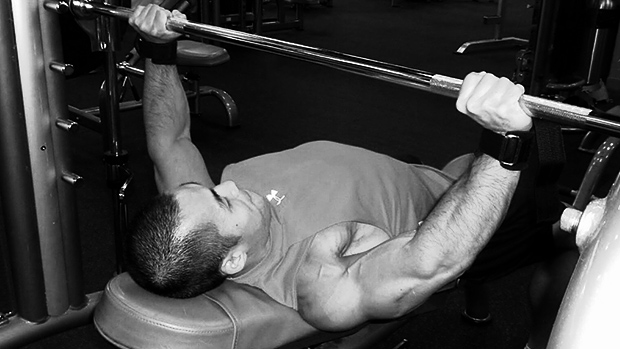Here's what you need to know about forearm workouts...
- While some guys are blessed with naturally big forearms, others need to work at it. The wrist roller is about the best exercise you can use for bigger forearms.
- Wrist rollers are inexpensive and can be made at home for next to nothing.
- Hold the roller down at your waist as opposed to shoulder height. Stand on a platform or box to compensate for the reduced range of motion.
- Simply add roller work to the end of your workout or use it as part of a giant-set forearm routine.
Some guys are blessed with the ability to grow impressive forearms simply by gripping heavy barbells and dumbbells. As such, they don't need much direct forearm work at all. However, they're also the genetic minority since most have the opposite problem – decent biceps development but forearms like a ballerina.
The good news is that for even the genetically hapless, the forearms respond very well in terms of both size and strength to hard consistent work with one exercise in particular – the wrist roller.
The muscles in the forearms are divided into two very broad groups, forearm flexors and forearm extensors. The forearm flexors are the stronger and larger of the two sections, and have several important jobs.
Finger flexion, in simple terms, means grip strength, of which there are two main types. Isometric grip strength is the ability to hold onto something such as a heavy deadlift. Concentric grip strength, more commonly referred to as crushing grip strength, is the ability to close your hand against resistance, as measured by the Captains of Crush grippers, for example.
Unfortunately the principle of specificity holds true and one type of grip strength doesn't automatically transfer to the other. In other words, isometric grip strength (which is more commonly developed in the gym through holding barbells, handles, etc.) doesn't automatically carry over to crushing grip strength (as measured by ripping phone books, plate pinches, rolling up frying pans, or just crushing your father-in-law's hand when you shake it).
The forearm extensors are responsible for extending the wrist. We don't do this movement often against a significant resistance in everyday life, but we frequently have to resist wrist flexion, which uses the extensors.
Exercises like reverse biceps curls and dumbbell lateral raises will work the forearm extensors to some degree as important stabilizers. Reverse wrist curls train this muscle group more directly.
The wrist roller is by far the best exercise for developing forearm size and strength. It is to your forearms what barbell squats are to your legs, if not better. There's simply no better substitute for this exercise for forearm workouts, and if you don't have access to one you can easily make one for around five bucks.
Most start off very humbled by the wrist roller and are lucky to use 10-15 pounds or less, but with consistency and applying gradual overload it's possible to work up to some impressive weights.
Another huge bonus of the wrist roller is that you must grip the roller to prevent it from slipping in the opposite direction, which works the flexors and develops crushing grip strength. From there, you can either work the extensors by rolling it extension style (you'll be able to go heavier with that form) or continue to hammer the flexors by rolling it flexion style.
Wrist Roller Flexion
Wrist Roller Extension
- Sometimes you'll see people holding the wrist roller out in front of them, mimicking the end position of a front raise. This is certainly harder and it does increase the range of motion (ROM), but your shoulders become the limiting factor almost immediately – and you should be able to wrist roll more than you can hold out in front of you for 30 seconds. I recommend keeping the weight down in front of your waist and either performing more rounds to increase the time under tension or standing on a box to increase the ROM. Furthermore, using plates no heavier than 25 pounds will also increase the ROM.
- When rolling, try to keep the wrist roller reasonably straight. If it's tilting at a significant angle as you roll, then your forearms aren't working as hard as they could be.
For programming, I like to first increase the rounds that I complete (starting on the ground and rolling up until the weight clicks is one round) and then increase the weight. Rolling the weight down as well as up is ideal, but you might find it's simply not feasible with certain rollers and heavier loads because it'll rip away your skin on the way down.
Increasing the rounds is ideal because the weight being lifted is quite light. Even a 2-5 pound increase is a large percentage increase and you'll tap out on your potential quite early if you just add weight.
Here are two programming options for the wrist roller. Plan A allows you to go heavier and focus more on strength, while plan B allows you to go lighter to focus more on endurance. Plan B will also give you a better pump, which is good for size development.
| Week | Plan A | Plan B |
|---|---|---|
| 1 | 25 (lbs.) x 1 round, 4 sets | 15 (lbs.) x 3 rounds, 4 sets |
| 2 | 25 x 2 rounds, 4 sets | 15 x 4 rounds, 4 sets |
| 3 | 25 x 3 rounds, 4 sets | 15 x 5 rounds, 4 sets |
| 4 | 27.5 x 1 round, 4 sets | 17.5 x 3 rounds, 4 sets |
| 5 | 27.5 x 2 rounds, 4 sets | 17.5 x 4 rounds, 4 sets |
| 6 | 27.5 x 3 rounds, 4 sets | 17.5 x 5 rounds, 4 sets |
| 7 | 30 x 1 round, 4 sets | 20 x 3 rounds, 4 sets |
Note: Four sets are performed – two sets flexion style, two sets extension style. I like to alternate them, starting with flexion since it's tougher.
There aren't too many lifters regularly using the wrist roller, nor are there hundreds of YouTube videos dedicated to it. I don't claim to have a perfect standardized way of ranking wrist roller strength but I can give you some rough guidelines.
My first goal with the wrist roller was to complete 45 pounds for 5 rounds. I hadn't seen anyone do this before and I always thought it would be pretty bad ass. To broaden it out, here are my standards using the strict exercise form described earlier:
Wrist Roller Standards
| Novice | Early Intermediate | Late Intermediate | Advanced | Super Stud |
|---|---|---|---|---|
| 10 x 3 | 25 x 3 | 50 x 3 | 75 x 3 | 100 x 3 |
You can simply incorporate the wrist roller into your regular workouts, or if you prefer you can use the following biceps/forearms specific circuit, which should really light you up. Perform this once a week:
Biceps and forearms circuit for an early-intermediate client:
| Exercise | Set 1 | Set 2 | Set 3 | Set 4 | Overload |
|---|---|---|---|---|---|
| Neutral Grip Pull-Up * | 6 | 6 | 6 | 6 | +1 rep/wk |
| Dumbbell Crossbody Curl | 25 x 8 | 25 x 8 | 25 x 8 | 25 x 8 | +1 rep/wk |
| EZ Reverse Curl | 60 x 8 | 60 x 8 | 60 x 8 | 60 x 8 | +1 rep/wk |
| Wrist Roller | 15 x 3 | 15 x 3 | 15 x 3 | 15 x 3 | +1 round/wk |
* Neutral Grip Pull-Up – Use rope pull-ups to really target the forearms.
The four exercises above are performed in a row without stopping; one set each, rest, and repeat. Once you can complete 12 reps, increase the weight.





